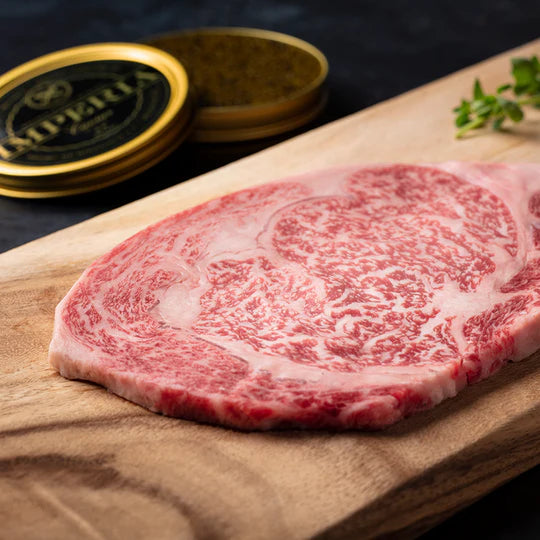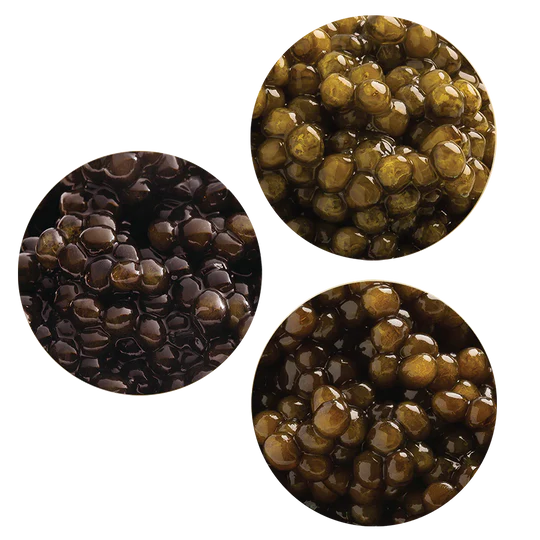We encounter many odd terms when learning about caviar, and this is all part of the mystique and appeal of this elite ingredient.
One of the terms that should definitely be part of your caviar vocabulary is malossol, a word commonly used to describe the top-quality caviar in the world.
What exactly does it take for caviar to earn the elusive malossol label, and how does this factor in the overall experience of tasting and enjoying caviar?
Today, let’s explore the meaning of malossol so that you have a deeper understanding and appreciation for top-tier caviar.
Malossol Definition
Malossol caviar is a specific term used to describe a certain caliber of caviar.
Let’s begin with the full definition of malossol and what goes into it.
Russian Translation
“Little salt” is the phrase we get when translating malossol from its Russian language roots. As you know, the strictest definition of caviar is “salted sturgeon roe” — malossol simply refers to the amount of salt used to provide a hint of flavor and longevity to fresh caviar.
We use the term malossol to distinguish the best caviar from lower-tier products, and if you want the finest caviar available, look for the malossol designation.
Malossol Salt Content
Just how much salt goes into malossol caviar? Any caviar expert will say that the upper limit is 5% salt, but true connoisseurs prefer malossol to be in the range of 3.7% salt content or less.
It’s possible for malossol caviar to be made with 1% salt or less, but you’ll find that most prestigious products use just a dash more salt to achieve the desired results.
The Preservation Process
In addition to being a category of caviar, malossol can also refer to the process of preservation used to make caviar of the highest quality.
The salt used in caviar production is extremely fine and absorbed fully into fresh water, with absolutely no impurities allowed. You should not detect any grains or granules of salt in your caviar tin if you’ve got true malossol.
After caviar goes through the initial sorting and rinsing process, water is drained away before the saltwater solution is carefully added to the batch.
From there, the caviar is chilled at low temperatures (around the freezing point of water) as it sits for a short period of time to absorb the salt.
The best malossol caviars tend not to be salted for more than an hour, ensuring that a minimal amount of salt soaks into the eggs. After salting, the caviar is drained, patted dry with a towel, then enters the final phase of packing and shipping.
Why Malossol Matters
We’ve explained the basics of malossol caviar and the parameters of production, but why does lower salt content matter in the overall experience of caviar?
Let’s find out.
Texture and Taste
The natural taste of caviar is slightly briny, often with hints of herbal, floral, and buttery flavors to complement it. By adding a bit of salt to the equation, these flavors are amplified and accentuated on the palate, which heightens the experience when tasting.
Salt in small amounts also serves to balance the levels of moisture in the caviar, creating slightly more tension on the surface of each egg and promoting the “pop” that many caviar lovers seek in every scoop.
Both the texture and taste are improved with the addition of salt, and the malossol tradition ensures that the perfect amount is added to achieve equilibrium.
Caviar in its Purest Form
All caviar enjoyers agree: sturgeon roe is best when it’s fresh. We mean really fresh! The sooner you get your caviar from the fish to a mother-of-pearl spoon or a blini, the better.
With that said, a small amount of salt ensures that the caviar is enhanced, but with the essential flavors and textures preserved to the greatest degree. With malossol, you can discern the subtle differences between Sevruga, Kaluga, Ossetra, and other famous caviars of the world.
The salt doesn’t overpower these strong, natural flavors — it only highlights them.
That’s why malossol is considered the purest form of caviar and why it tends to fetch higher prices in the marketplace.
Malossol Alternatives
If caviar isn’t malossol, then what is it?
There are many other caviar products available, and categorizing them by salt content makes for easy sorting.
Here are some other terms to keep in mind:
- Salted Caviar: up to 8% salt content, also called Semi-Preserved Caviar
- Payusnaya: greater than 10% salt content, also called Pressed Caviar
You may also encounter pasteurized caviar with varying levels of salt content, so always read your labels and know exactly how much salt to expect.
Finding the Best Malossol Caviar
Fresh and delicious malossol caviar is more accessible than any other time in history.
Follow these tips to get the best malossol caviar on your table:
Trusted Vendors
If you buy caviar from a local shop or storefront, be sure that the malossol caviar you select is fresh and properly stored. After all, malossol is best enjoyed ASAP.
With the rise of the web, you can also have malossol caviar shipped to your door, provided the vendor is trusted and features plenty of glowing online reviews.
Proper Shipping and Storage
Shipping should be expedient and professional when dealing with malossol caviar.
As soon as the shipment lands on your doorstep, quickly move it to a cold part of your refrigerator and be ready to serve it in less than two weeks. Once the jar is open, you have 48 hours before it starts to turn.
Serving Malossol Caviar
Malossol caviar should be served with traditional settings, garnishes, drinks, and utensils. We suggest trying a bite of pure malossol caviar with minimal accouterments, exploring the full spectrum of flavor and texture.
Enjoy the World’s Finest Malossol Caviar
Now that you know the meaning of malossol caviar, you’ve got another advantage as you navigate the caviar market.
Use this term when shopping around and remember — nothing compares to malossol in the world of caviar.



